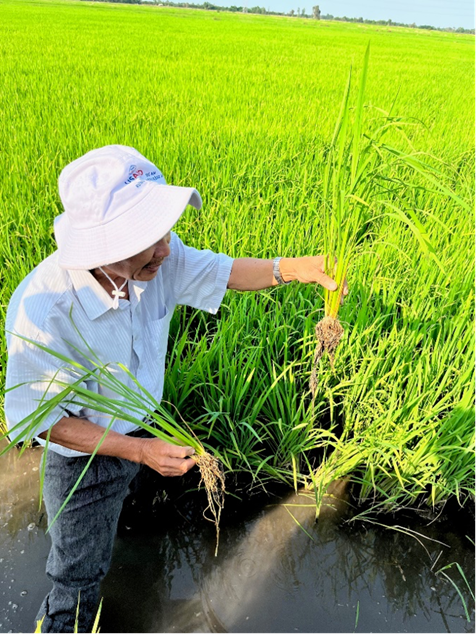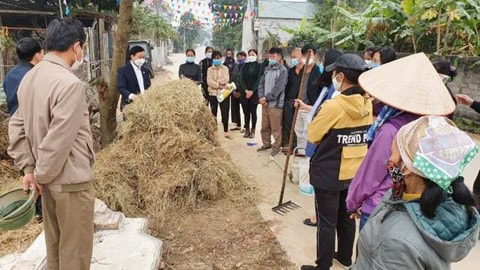Climate-Smart Rice Cultivation Initiative in Northern Vietnam
Rice production is one of the major contributors to greenhouse gas emissions from agriculture. Traditional rice cultivation practices - such as excessive use of fertilisers, rice straw burning, and continuous flooding of rice fields - cause significant greenhouse gas emissions, as well as air and water pollution. To address these challenges, Vietnam, one of the world’s largest rice producers, has committed to transforming its rice industry by reducing the use of chemical fertilisers and greenhouse gas emissions in rice production.
Through EarthCare Foundation, Quantedge Advancement Initiative has joined four other Asia-based funders to support the ‘Dissemination and Mobilization of Farmers in Applying Environment Friendly Rice Cultivation in Vietnam’ project. Implemented by the Vietnam Farmers’ Union (VNFU), this project promotes the adoption of three climate-smart rice cultivation techniques among local smallholder rice farmers:
In addition to the potential to reduce greenhouse gas emissions from rice production by more than 20%¹, transitioning to these climate-smart techniques bring other co-benefits such as reduced air and water pollution, and improved livelihoods of local farmers. It also has the potential to increase paddy field profitability, with a previous pilot trial in the southern Mekong Delta region showing an ~18% increase in profitability in plots where the techniques were applied.
Through EarthCare Foundation, Quantedge Advancement Initiative has joined four other Asia-based funders to support the ‘Dissemination and Mobilization of Farmers in Applying Environment Friendly Rice Cultivation in Vietnam’ project. Implemented by the Vietnam Farmers’ Union (VNFU), this project promotes the adoption of three climate-smart rice cultivation techniques among local smallholder rice farmers:
- Reduced use of chemical fertilisers through utilising the Leaf Colour Chart to reduce nitrous oxide emissions;
- Alternative use of rice straw by composting instead of burning to reduce pollutants, or planting dryland crops during rice fallow periods to improve soil quality for the next rice crop; and
- Alternate wetting and drying (intermittent flooding of rice fields) to reduce methane emissions.
In addition to the potential to reduce greenhouse gas emissions from rice production by more than 20%¹, transitioning to these climate-smart techniques bring other co-benefits such as reduced air and water pollution, and improved livelihoods of local farmers. It also has the potential to increase paddy field profitability, with a previous pilot trial in the southern Mekong Delta region showing an ~18% increase in profitability in plots where the techniques were applied.
(Left) A project technical expert comparing rice plants: The plant on the lower left has been grown with conventional methods and the plant on the upper right has been grown with climate-smart rice techniques. The climate-smart rice has yet to be fertilised with chemical fertiliser, yet it shows more robust roots and less incidence of disease. (Photo credit: EarthCare Foundation)
(Right) A training on composting as a straw management technique in Bac Giang province. (Photo credit: Vietnam Farmers’ Union)
(Right) A training on composting as a straw management technique in Bac Giang province. (Photo credit: Vietnam Farmers’ Union)
The VNFU will engage local farmer groups and extension services to promote these techniques and build a community of climate-smart rice farmers. The approaches will be informed by behavioural science to ensure that changes in the farmers’ behaviour are sustained in the long run.
Our support for the ‘Dissemination and Mobilization of Farmers in Applying Environment Friendly Rice Cultivation in Vietnam’ project will help inform the large-scale adoption of climate-smart rice cultivation techniques in Vietnam in the future. This will in turn contribute to climate change mitigation at scale and ultimately improve the livelihoods of Vietnamese farmers.
Find out more:
Our support for the ‘Dissemination and Mobilization of Farmers in Applying Environment Friendly Rice Cultivation in Vietnam’ project will help inform the large-scale adoption of climate-smart rice cultivation techniques in Vietnam in the future. This will in turn contribute to climate change mitigation at scale and ultimately improve the livelihoods of Vietnamese farmers.
Find out more:
References:
¹ The World Bank. “Vietnam: New Farming Methods Help Save Costs, Boost Incomes and Reduce GHG Emissions.” The World Bank, 2022. https://www.worldbank.org/en/news/video/2022/09/24/vietnam-new-farming-methods-help-save-costs-boost-incomes-and-reduce-ghg-emissions.
¹ The World Bank. “Vietnam: New Farming Methods Help Save Costs, Boost Incomes and Reduce GHG Emissions.” The World Bank, 2022. https://www.worldbank.org/en/news/video/2022/09/24/vietnam-new-farming-methods-help-save-costs-boost-incomes-and-reduce-ghg-emissions.


